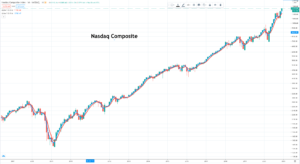

I don’t often look at the Nasdaq Composite index, which is a broad based index measuring the performance of shares quoted on the NASDAQ marketplace but as you can see it is doing very well. There is even a new chart breakout, which could be promising. Below I look at three exciting businesses, two newcomers to Wall Street, not necessarily quoted on NASDAQ; I haven’t checked but it makes no difference these days since all the markets are electronic and one, which is based in Germany and listed in Europe. There have been an incredible number of IPOs on Wall Street this year but most of them don’t make the cut for inclusion in QV. The two discussed below do and both, in different ways, look incredibly exciting. The third one, quoted in Europe, also looks a vintage addition to the portfolio.
Airbnb ABNB Buy @ $156 MV: $93bn Next figures due: not known but the group has a 31 December year end New entry
Most of you will be familiar with Airbnb and may even have stayed in places using the platform. My home in the New Forest is listed on Airbnb and until everything was confused by lockdown it was doing very well. My daughter is a superhost. We also now use Airbnb as a family when we stay anywhere else. You get great deals, great properties and great service. I am not surprised the business has grown so strongly although inevitably it took a massive hit, especially in the early stages of lockdown, when the company took the decision to provide financial assistance to hosts, who were reeling from a wave of cancellations. Indeed, by late April, commentators were asking if this was the end for Airbnb. The company has weathered the storm and business has already picked up strongly. Most exciting though is that the group has established the brand on a global scale but its market share is tiny in relation to the size of the global hospitality market. It is obvious that Airbnb could become a huge and highly profitable business; by most people’s standards it already is big albeit still lossmaking but it is operating in a market place valued in the trillions of dollars.
The business was founded, almost by accident, in 2007 by guys, who quickly realised the potential of what they were doing. I think of Airbnb a bit like Uber for homes but I suspect that the potential for Airbnb is far greater because they have already gone from first mover advantage to what looks very like winner takes all. As co-founder and CEO, 39 year old Brian Chesky, put it, Airbnb has created a new category in the hospitality market. They are obviously not a hotel business but nor are they an online travel agency like Booking.com or Expedia. They have created the system of trust which enables strangers to share a house together and the payments systems and reviewing systems that also inspire confidence. Now they have built a global brand which is recognised in 200 countries; they have four million hosts and over 500m people have used Airbnb to find a place to stay. They have also weathered or are weathering Covid-19, the biggest shock imaginable for a travel and hospitality related business and have even been able to stage a spectacularly successful IPO, while the virus is still having a damaging impact.
In a nutshell I feel they have done the hard bit and now what they need to do is roll out their empire across the planet, recruiting more hosts and entertaining more guests.
According to the prospectus “Airbnb has enabled home sharing at a global scale and created a new category of travel. Instead of traveling like tourists and feeling like outsiders, guests on Airbnb can stay in neighborhoods where people live, have authentic experiences, live like locals, and spend time with locals in approximately 100,000 cities around the world. In our early days, we described this new type of travel with the tagline “Travel like a human.” Today, people simply refer to it with a single word: “Airbnb.” Alphabet created a new verb – ‘google’ and we know how valuable that has become. Alphabet is valued at $1,167bn and the business is still growing strongly. It could be a pointer to the prospects for Airbnb.
“What began with our hosts sharing their spare bedrooms on Airbnb in a few large cities has grown into hosts listing spaces of all kinds, in communities of all sizes, in nearly every corner of the world. Today, hosts even share their interests and talents through Airbnb Experiences. We believe that we have just scratched the surface of the opportunities that hosting provides. There are many more ways people will want to connect with each other and the world around them, and so we will continue to design and enable new ways to host. No matter what form it takes, hosting will be at the centre of Airbnb.” I know what he means. My house in the New Forest sleeps 14 yet at one stage a single family rented it for three months; that was great for us but the family loved it too.
Although the business is not yet profitable it was ebitda positive in 2018 and 2019 and Chesky is very confident of the business model going forward. As a platform to match hosts with guests it is capital light [no need for heavy capital expenditure] and as a community of users it is almost infinitely scaleable; that sounds like a business that should be very profitable one day.
Growth has already been highly impressive. “We have experienced rapid growth since our founding. In 2019, we generated gross booking value (“GBV”) of $38bn, representing growth of 29pc from $29.4bn in 2018, and revenue of $4.8bn, representing growth of 32pc from $3.7bn in 2018. During the nine months ended September 30, 2020, our business was materially impacted by the global COVID-19 pandemic, with GBV of $18bn, down 39pc year over year and revenue of $2.5bn, down 32pc year over year.”
The business is still all about growth. “We believe that we are still early in the global shift in consumer preferences toward one-of-a-kind stays and experiences, which provides an opportunity to further grow our community and business. As a result, we have consistently reinvested the free cash flow that we have generated to meet our business needs and expand our operations.”
The opportunity is massive. “We have a substantial market opportunity in the growing travel market and experience economy. We estimate our serviceable addressable market (“SAM”) today to be $1.5 trillion, including $1.2 trillion for short-term stays and $239bn for experiences. We estimate our total addressable market (“TAM”) to be $3.4 trillion, including $1.8 trillion for short-term stays, $210bn for long-term stays, and $1.4 trillion for experiences. We have estimated key components of our SAM and TAM using 2019 actual figures and believe our market opportunity can grow over the long term at the rate of travel spending.”
At this point a conventional share analysis would start to talk about the valuation and would typically end up by concluding that the shares are exciting but far too expensive to buy. Fortunately, I don’t bother with that; all I want to know is that the business is exciting. If it is then my advice is to buy the shares, right away. I leave the market to sort out the value and time and again it turns out that what looked expensive is actually very cheap.
C3.ai AI Buy @ $137 MV: $12.7bn Next figures due: not known but the company has a 30 April year end. New entry.
Just so we know what we are dealing with here C3.ai (code: AI) is one of the most highly valued businesses I have ever encountered. In the last full year to 30 April 2020 AI made a loss and had sales of $157m. This means it is valued at 81 times sales. Not only that but growth in the latest quarter slowed dramatically as the global economy went into lockdown. Investors, who are buying at this level evidently think this is not about valuation but about the potential for a very exciting concept, a company which enables organisations to apply artificial intelligence at scale to solve their problems and improve their performance. As you can imagine I am struggling to get my head around exactly what C3.ai does but it feels incredibly exciting and the CEO and founder, Tom Siebel, is a silicon valley legend, who was an ear;y recruit to Oracle when that company was a start-up and then went on to found Siebel Systems.
This is what he says in the AI prospectus about Siebel Systems. “In July of 1993, convinced that this presented a huge unserved market opportunity, I founded Siebel Systems, a computer software company committed to successfully applying this new step function of information and communications technology to the business processes of sales, marketing, and customer service. That too turned out to be a good idea. Six years later, Siebel Systems exceeded $2bn in revenue with 8,000 employees in 29 countries, becoming one of the fastest growing enterprise software companies in history. At Siebel Systems, I believe we invented the CRM market as you know it today, and established a clear global market leading position in that market. Siebel Systems merged with Oracle in 2006. The CRM market is now a $60+ billion software industry.
There are two key reasons. other than the leadership of Tom Siebel, why C3.ai is so exciting.
First; it delivers great returns for its customers. “We are enabling the digital transformation of many of the world’s leading organizations and, in the process, helping them to attain short time-to-value and exceptionally high economic returns. At some companies, based on feedback from our customers, we estimate our solutions have resulted in hundreds of millions of dollars in annual economic benefit. We estimate, based on our production C3.ai roadmaps, that we may enable billions of dollars in annual economic benefit for our customers. The key to our market success to date, and our primary competitive differentiator, is our ability to leverage the C3 AI Suite and C3 AI Applications to bring high-value enterprise AI applications into production use rapidly. We have deployed enterprise AI applications into production use in as little as four weeks. As a result of the high-value outcomes that we enable, we enjoy uncommonly high total contract values for software subscriptions. Our average total contract value for contracts entered into in fiscal years 2016, 2017, 2018, 2019, and 2020 was $1.2m, $11.7m, $10.8mn, $16.2m, and $12.1m, respectively. We believe this is a high-water mark for the applications software industry. We are able to drive these extraordinary contract values because of the high-value outcomes we provide to our customers—we enable some of the largest companies in the world to succeed in their most mission-critical digital transformation projects. We expect the average total contract value to decrease as we expand our customer base beyond a small number of large lighthouse customers to a larger number of smaller customers.”
Second, is the size of the addressable market. “We serve a large and rapidly growing market, estimated to be $174bn in 2020, growing to $271bn in 2024, a 12pc compound annual growth rate, or CAGR. Our solutions address use cases across: enterprise AI software, a market valued at $18bn in 2020 and forecast to reach $44bn in 2024, a 24pc CAGR; enterprise infrastructure software, application development, infrastructure, and middleware; data integration and quality tools, and master data management products, a market valued at $63bn in 2020 and forecast to reach $82bn in 2024, a 7pc CAGR and enterprise applications. analytics, business intelligence and customer relationship management, or CRM. a market valued at $93bn in 2020 and forecast to reach $145bn in 2024, a 12pc CAGR.By any standards, this is a large and rapidly growing addressable market opportunity.”
A third argument could be AI’s position in this market. “We believe we enjoy a significant first-mover advantage in enterprise AI, based on our significant investment in our products and technology over the last decade of development. We are not aware of others who have made as much progress as we have in this space. We believe that we have the world’s most extensive enterprise AI production footprint. Our goal is to establish and maintain a global leadership position in enterprise AI across all market segments including large enterprises, small and medium businesses, and government entities.” They are clearly playing for massive stakes so any evidence that they are on course to realise their goals will be very positive news for the share price.
C3.ai is an enterprise software business that generates most of its revenue from subscriptions, the classic recurring revenue business model that investors love and for which they are ready to pay highly. The company also operates the classic land and expand business strategy. Customers start small, or not so small in AI’s case and then increase their spend in subsequent years. “After their initial contract with us, our customers tend to expand the use of our products and, as a result, may purchase additional applications, additional developer seats, additional software products, additional runtime usage, and additional services. We define a customer as a separate buying entity that has an active contract to deploy the C3 AI suite or one or more C3 AI applications. We often provide our software to a distinct department, business unit, or group within such single buying entity and define a customer as each distinct department, unit, or group within a customer. The average initial contract value with our largest 15 customers was $12.8m. On average, each of these customers has purchased an additional $26.1m in product subscriptions and services from us to date as they expanded existing use cases and added additional use cases to their roadmaps.”
Another exciting feature of C3.ai is that the company is at such an early stage in its growth path, almost proof of concept. “We have established strategic relationships with technology leaders including AWS [Amazon Web Services], Baker Hughes, Fidelity National Information Services, or FIS, Google, IBM, Microsoft, and Raytheon, marshalling tens of thousands of talented resources from the world’s leading technology companies to establish and serve C3.ai customer relationships at global scale. Our market entry growth strategy has been to employ a direct sales organisation organised in a traditional geographic/industry market matrix, partnered with C3.ai technical experts in our forward deployed engineering organisation, to establish and expand customer relationships with large lighthouse customers with a diversity of AI use cases across a range of industry segments. Our sales and engagement efforts are frequently closely coordinated with our marketing partners including AWS, Baker Hughes, FIS, Google, IBM, and Microsoft. Having established the scalability of our product offerings and their utility across a wide range of AI use cases at large-enterprise scale, we will now (1) expand those same use cases across similar companies, (2) establish middle market sales organisations, including telesales and online sales, and (3) leverage our marketing partners as enterprise and mid-market distribution channels.”
The talent pool on which they are able to draw is amazing. “Our strongest asset is unquestionably the human capital we have been able to attract, retain, and motivate. We have won the Glassdoor Best Place to Work award, were named a WayUp Top 100 Internship Program, and are consistently ranked among the best places to work. We attract exceptionally talented, highly educated, experienced, motivated employees. We hired 214 new employees in the past year. We received approximately 52,000 applications for those positions. Approximately 10,000 of those were engaged in rigorous skill evaluation and interview cycles for a final selection of 214. Fifty-seven percent of our employees have advanced degrees, many from the world’s most prestigious institutions.”
The company sums up what is all about as follows. “Enterprise AI is a huge addressable market. We have a highly experienced CEO and management team with an established track record of identifying large technology markets in their nascent stage, developing innovative, superior solutions to meet the needs of those markets, assembling and organising high-performance organisations, and building rapidly growing, financially sound, cash-positive, profitable, professionally managed, market-leading companies that accrue substantial value to customers, employees, partners, and investors. We have developed a patented enterprise AI suite enabling the successful digital transformation of leading corporations and government entities. First-mover advantage, technology leadership, substantial market eco-system, recognized enterprise AI market leadership, a high-performance corporate culture and focused on excellence in execution. We are in this for the long run, with the singular focus of establishing and maintaining recognized technology innovation and global market leadership in the enterprise AI application software market.”
If this company manages to do what it says on the tin it is going to become huge; that is the reason for buying the shares.
Delivery Hero DHER €119 MV: €23.7bn Next figures: 25 April New entry (based in Berlin)
This is what Delivery Hero does. “As of January 2020, we have over 500,000 contracted restaurants on our platform, our delivery fleet delivers food in less than 28 minutes on average and below 15 minutes for our instant grocery area. As the world has evolved from Commerce to eCommerce, we have now entered the new era of QuickCommerce. Today, l believe we are one of the global leaders in this fairly new category. To be able to operate this category profitably, an enormous amount of work and technology has been developed. Everything from inventory management, rider operations and also AI solutions for routing, mapping, dynamic pricing, area optimisation, time estimations, forecasting and customer personalisation to mention only a few.” And this is how well they do it. “In terms of corporate development, the sale of our German operations at the beginning of 2019 enabled us to redistribute our resources and strengthen our global presence. We focused on strengthening our position in MENA [Middel East & North Africa] and invest more into growth markets where we believe we can gain leadership over the next 5–10 years. Today, we operate in 44 countries at large scale, being the fastest-growing listed online delivery company. The accelerator for this fast expansion has been the Asia segment, where we nearly tripled our orders from 83m to 227m in 2019. Much of the success can be attributed to the combination of centralised technology, marketing and other services supported by the local founders and their high-performing teams.”
Excitement levels within the business are high. “I am convinced we are only in the early days of this fascinating journey. There are unlimited opportunities where we can innovate for our customers, delivering an amazing experience – fast and easy to the door.” The company also says “By 2021 we aim to be CO2 neutral globally.” Even with Delivery Hero it is all about technology. “We are particularly proud to hold innovation at the core of our culture, as it is our key strength when it comes to tackling the market opportunity. Our vision to always deliver amazing experiences, is driven by continuous and unparalleled investment into customer experience.”
Delivery Hero is an extraordinary business. “By operating a hybrid delivery platform – meaning operating as a marketplace as well as having own-delivery capabilities – Delivery Hero ensures the best quantity, quality and choice to the consumer. As of January 2020, we achieved the important milestone of 500,000 active restaurants listed across our platforms. This makes Delivery Hero the global leader in online food delivery, with the biggest restaurant network globally outside of China……We are deeply integrated with the operations of our restaurant partners, which allows us to learn the cooking times of their dishes and make sure the food is ready exactly at the time the delivery rider arrives at the restaurant, all to improve speed, reliability and food quality…..With improved logistic efficiencies we decreased delivery time to below 28 minutes in Q4 2019, with even faster execution in dense areas. Improved unit economics, that in some markets (i.e., KSA – Kingdom of Saudi Arabia) are even exceeding those of marketplace orders, is the result of significant investment as well as numerous years building and refining our delivery technology and restaurant operations…..We are passionate about taking our customers’ ordering experience to the next level. Each day we focus on simplifying and personalising our product, so that we can continually move closer to the point where we know exactly what each customer wants, when they want it. Our data-driven approach has led to 22bn data points being processed in December 2019….Our proprietary algorithm estimates vendor preparation times based on the day of the week, the time of the day and the size of the order to match the time the food is ready with the time our rider gets to the restaurant, in order to improve the food quality by reducing the time the food stays in the bag….Developments in proprietary technology and executional capabilities allowed us to expand into multi-vertical offerings in multiple markets, this includes products from groceries, pharmacies, flower stores and other convenience articles. Throughout 2019 we rolled out multi-vertical delivery platforms in 29 countries. During 2019, multi-verticals surpassed the threshold of 1m orders per month.”
Q3 2020 results showed the strong growth continuing. “Delivery Hero maintained a strong growth trajectory in Q3 2020, with orders doubling yoy to 362m, revenue up 99pc to €776m and gross merchandise volume (GMV) up 70pc to €3.4bn. Acquisitions of Glovo’s Latin American business and InstaShop, as well as the launch of Japan, helped expand Delivery Hero’s footprint globally. Quick commerce is now live in 40+ markets with over 30,000 partner stores globally and 254 Dmarts [Dmarts, also known as cloud stores, are strategically located in densely populated areas. Each store has several thousand items in stock and inventories are constantly being adjusted based on data insights and customer feedback]. Delivery Hero updates the full-year revenue outlook from €2.6-2.8bn to €2.7-2.8bn. This marks the seventh successive quarter, where growth has been around 100pc. The company maintained a relentless focus on expanding its offering, including quick commerce, (the next generation of e-commerce, bringing groceries and household products to customers in under 60 minutes), which is now live in 41 markets. Q3 also saw Delivery Hero enter the DAX, consisting of the top 30 German companies listed on the Frankfurt stock exchange, signaling the market’s strong belief in Delivery Hero’s growth strategy.”
There is no doubt that Delivery Hero is an exciting business, classic 3G with plenty of magic and a strong following wind. It goes into the QV portfolio.

History suggests that the first time a share is recommended is the best time to buy. Each of the three shares above is classic 3G and this is the first time they are being alerted. It should prove a good time to buy the shares albeit it is a pity I didn’t discover Delivery Hero sooner. It looks a very exciting business with great, visionary leadership.



